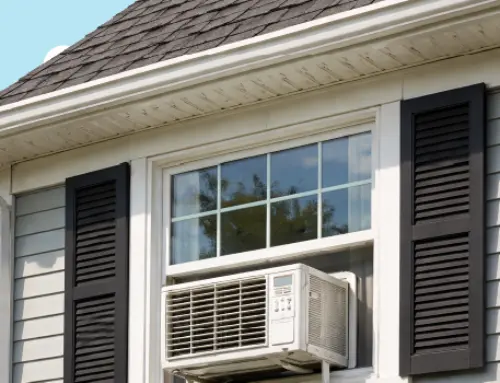Do Christmas Lights Use a Lot of Electricity?
by Jenna Mendez
14 min read
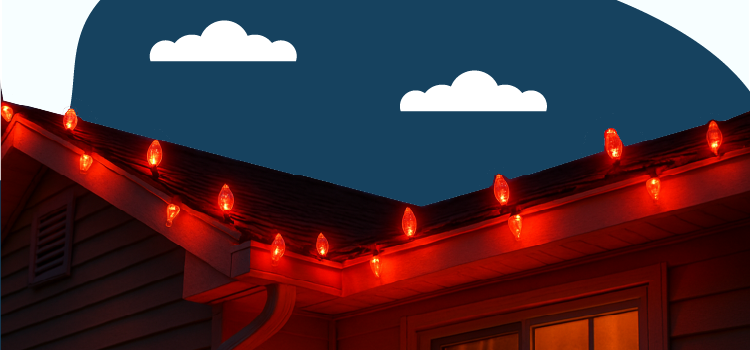
Looking to deck the halls? Christmas lights can use a significant amount of electricity, but it depends on the type of lights and how many are used. Holiday lights can add up on your energy bill, but the impact largely comes down to the type of lights you use, how many strands you hang, and how long you leave them on each night.
Wondering how much electricity Christmas lights use and how much it’ll cost you? Let us energy experts break it down for you. From light type to the number of bulbs you use, we’ve got what you need to know.
Key Points of This Article:
- LED Christmas lights are significantly more energy-efficient than traditional incandescent bulbs, using up to 99% less electricity and costing only pennies per day to operate.
- The type and number of bulbs used greatly affect your electric bill, with larger bulbs like C9s consuming much more power than mini LEDs, especially when used in large displays.
- Running lights for extended hours, especially overnight, can double your electricity costs, and using timers or smart plugs is recommended to reduce waste and improve safety.
- Switching to LED lights not only lowers energy costs but also improves safety and longevity, making them a smart choice for festive displays without the financial or fire risks of older bulbs.
How Much Electricity Do Christmas Lights Use?
When it comes to holiday lighting, the amount of electricity your display consumes depends heavily on the type of strand and bulb you choose.
A traditional mini incandescent Christmas light strand with 100 bulbs uses about 50 watts total, or 0.05 kW. If you're looking to measure in kilowatt hours, (we recommend this since this is the unit of electricity measurement you'll see on your electricity bill) you're looking at about 0.30 kWh if you run your lights for 6 hours.
If you step up to C7 bulbs (medium-sized bulbs about the size of a nightlight, that are commonly used for indoor trees or smaller outdoor accents) then your energy use jumps to 500–700 watts (0.5–0.7 kW) or 3.0–4.2 kWh of electricity in 6 hours.
The larger C9 bulbs that are brighter bulbs about the size of a small thumb, often used for rooflines, big trees, and outdoor displays where maximum visibility is desired, are even more demanding. They draw 700–1,000 watts (0.7–1.0 kW) or 4.2 to 6.0 kWh of electricity in 6 hours.
A single LED mini string 4.8 watts total (0.0048 kW) uses about the same electricity as charging your smartphone for an hour or two; or around 0.029 kWh of electricity.
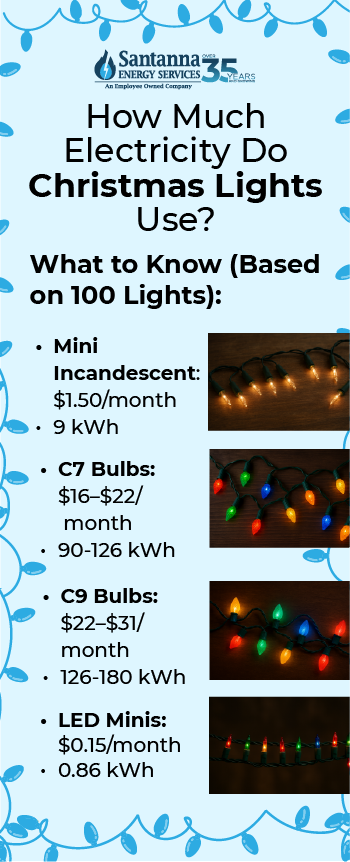
How Much Power Do Your Holiday Lights Really Use?
According to Avista Utilities, it can take around 700 mini lights to fully decorate a seven-foot tree, so a single 100-light strand may not go as far as you think.
When it comes to energy use, the type of bulb makes all the difference. Older incandescent strands draw far more power than today's efficient LEDs. For example, a 100-bulb mini incandescent string uses about 0.05 kilowatt-hours (kWh) per hour.
Interested in more? Here's how much energy these types of Christmas lights would use if you ran them for 6 hours per day, week, and month:
How Much Electricity Do 100 Christmas Lights Use?
| Light Type | kWh per Hour | kWh per Day (6 hrs) | kWh per Week (42 hrs) | kWh per Month (180 hrs) |
| Mini Incandescent (0.5 W) | 0.05 kWh | 0.3 kWh | 2.1 kWh | 9 kWh |
| C7 Bulbs (5–7 W) | 0.5–0.7 kWh | 3–4.2 kWh | 21–29.4 kWh | 90–126 kWh |
| C9 Bulbs (7–10 W) | 0.7–1.0 kWh | 4.2–6 kWh | 29.4–42 kWh | 126–180 kWh |
| LED Mini String (4.8 W) | 0.0048 kWh | 0.0288 kWh | 0.2016 kWh | 0.864 kWh |
Running 100 C9 bulbs for 6 hours a day uses up to 6 kWh per day; about the same energy a typical refrigerator consumes in 24 hours!
Switching to 100 LED minis drops that to just 0.03 kWh, roughly the energy to charge a smartphone less than once.
How Much Electricity Do 200 Christmas Lights Use?
| Light Type | kWh per Hour | kWh per Day (6 hrs) | kWh per Week (42 hrs) | kWh per Month (180 hrs) |
| Mini Incandescent (0.5 W) | 0.10 kWh | 0.6 kWh | 4.2 kWh | 18 kWh |
| C7 Bulbs (5–7 W) | 1.0–1.4 kWh | 6–8.4 kWh | 42–58.8 kWh | 180–252 kWh |
| C9 Bulbs (7–10 W) | 1.4–2.0 kWh | 8.4–12 kWh | 58.8–84 kWh | 252–360 kWh |
| LED Mini String (4.8 W) | 0.0096 kWh | 0.0576 kWh | 0.4032 kWh | 1.728 kWh |
Two hundred mini incandescents need 0.6 kWh a day, close to what it takes to run a clothes iron for 30 minutes.
The same number of LED minis draws just 0.06 kWh, similar to keeping a laptop on sleep mode overnight.
How Much Electricity Do 300 Christmas Lights Use?
| Light Type | kWh per Hour | kWh per Day (6 hrs) | kWh per Week (42 hrs) | kWh per Month (180 hrs) |
| Mini Incandescent (0.5 W) | 0.15 kWh | 0.9 kWh | 6.3 kWh | 27 kWh |
| C7 Bulbs (5–7 W) | 1.5–2.1 kWh | 9–12.6 kWh | 63–88.2 kWh | 270–378 kWh |
| C9 Bulbs (7–10 W) | 2.1–3.0 kWh | 12.6–18 kWh | 88.2–126 kWh | 378–540 kWh |
| LED Mini String (4.8 W) | 0.0144 kWh | 0.0864 kWh | 0.6048 kWh | 2.592 kWh |
A 300-light string of C9 bulbs can hit 18 kWh per day, about the same as running a central A/C unit for three hours!
LEDs at this size barely reach 0.09 kWh, equivalent to brewing a single pot of coffee.
How Much Electricity Do 400 Christmas Lights Use?
| Light Type | kWh per Hour | kWh per Day (6 hrs) | kWh per Week (42 hrs) | kWh per Month (180 hrs) |
| Mini Incandescent (0.5 W) | 0.20 kWh | 1.2 kWh | 8.4 kWh | 36 kWh |
| C7 Bulbs (5–7 W) | 2.0–2.8 kWh | 12–16.8 kWh | 84–117.6 kWh | 360–504 kWh |
| C9 Bulbs (7–10 W) | 2.8–4.0 kWh | 16.8–24 kWh | 117.6–168 kWh | 504–720 kWh |
| LED Mini String (4.8 W) | 0.0192 kWh | 0.1152 kWh | 0.8064 kWh | 3.456 kWh |
No matter the strand size you use, it’s clear to see that LED minis use a tiny fraction of the power of traditional bulbs. Compared to standard incandescent C7 or C9 bulbs, LED Christmas lights use a whopping 99% less energy per day.
That pattern holds as you add more lights. At 300 bulbs, LEDs draw only 0.086 kWh per day, while mini incandescent bulbs need 0.9 kWh, again a roughly 90 percent savings. And on top of this, according to the Department of Energy, LEDs last 3-5 times longer than incandescent bulbs, so it’s a win-win!
If you have the chance this holiday season and are looking to save some serious energy on your display, we strongly recommend picking up some LED light bulbs.
Do LED Christmas Lights Use a Lot of Electricity?
The short answer is, no, LED Christmas lights use very little electricity compared to traditional incandescent bulbs. From our calculations, we've found that LED Christmas lights use 99% less energy per day than incandescent Christmas lights.
They're designed to be highly energy-efficient, so you can decorate your home inside and out without worrying about a big jump in your electric bill.
Unlike incandescent lights that waste most of their energy as heat, we've found that LEDs convert more of their energy into light, which makes them safer to use around trees, fabrics, and outdoor displays.
Do Christmas Lights Really Raise Your Electric Bill?
We've seen it! Yes, Christmas lights will raise your electric bill, but how much depends on the choices you make, the type of bulb, the number of strands you use, and how long you keep them on each night all play a big role in the impact on your bill.
Incandescent bulbs are far less efficient and draw much more power. The more strands of these you use, the more noticeable the difference will be on your bill. In contrast, modern LED Christmas lights are designed to be extremely energy efficient. Even with a larger display, the increase in your bill is minimal compared to incandescent lights.
How Much Do Christmas Lights Add to Your Electric Bill?
Christmas lights can add anywhere from just a few cents to over $30 to your monthly electricity bill, depending on the type of bulbs you use and how long you keep them on each night.
Most homeowners don't think about the exact cost of running their holiday lights until the January bill arrives. But understanding the electricity use of different light types helps you make smarter choices about your display
Using the U.S. average electricity rate of 17.47¢ per kWh from E.I.A. as of May 2025, here's how much it costs to run Christmas lights of different types based on 100 lights:
How Much Christmas Lights Will Cost You by Bulb Type
| Light Type | Cost per Hour | Cost per Day (6 hrs) | Cost per Week (42 hrs) | Cost per Month (180 hrs) |
| Mini Incandescent | $0.01 | $0.05 | $0.37 | $1.57 |
| C7 Bulbs | $0.09–$0.12 | $0.52–$0.73 | $3.67–$5.14 | $15.72–$22.01 |
| C9 Bulbs | $0.12–$0.17 | $0.73–$1.05 | $5.14–$7.34 | $22.01–$31.45 |
| LED Mini String | ≈$0.00 | $0.01 | $0.04 | $0.15 |
LEDs cost pennies while traditional bulbs add up fast. Running a 100-light LED mini string for six hours costs only about 1 cent per day, or 15 cents for an entire month. In contrast, mini incandescents are roughly 10 times more expensive.
How Much It Costs to Run Small, Medium, and Large Christmas Displays
What does that look like on a real house? We’ve done the work for you. Here are three common display sizes with estimated costs for LED vs. Incandescent displays. Use our assumptions below so you can adapt for your home:
Typical Display (Lights on Bushes, About 1,000 lights)
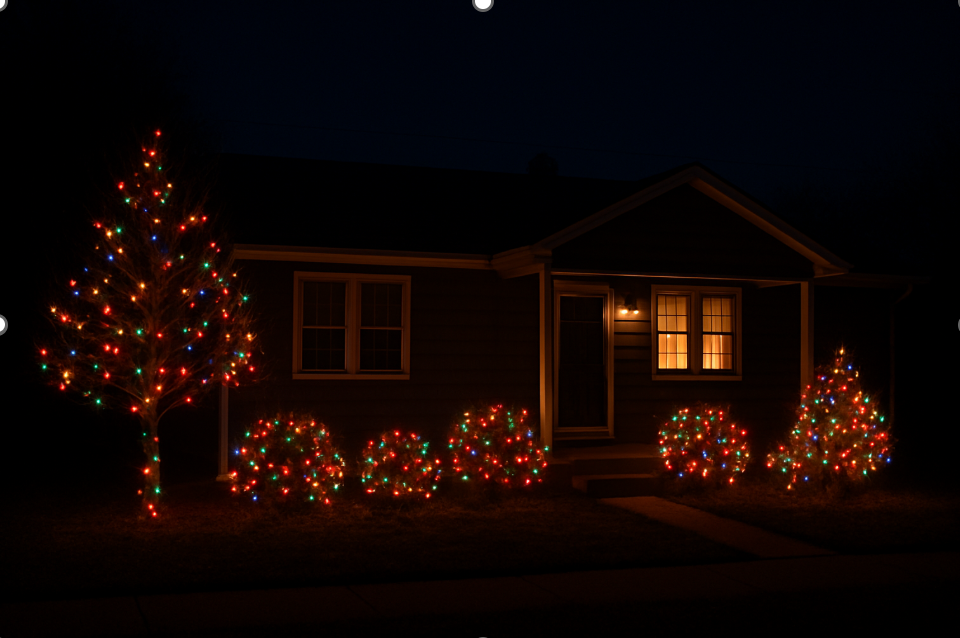
A classic Midwest setup might include a few shrubs and small trees wrapped with about 1,000 lights. Based on our estimates, running this display for six hours each night over a month might cost roughly $10–$12 with incandescent bulbs, but only $1–$2 with LEDs. Even with nightly use, LEDs keep this cozy yard glow to just pennies a night.
Heavy Display (Full Roofline, Windows, Porch Rails, 2–3 trees, About 3,000 Lights)

For a bolder look, many homeowners outline porch rails, tree trunks, and windows and cover more bushes, using around 3,000 lights. Based on our estimates, operating this heavier display for the season adds about $100–$120 to the bill with incandescents, compared to only around $15 with LEDs.
Enthusiastic Display (Whole-House Outline, Yard Features, Mega Tree, About 6,000 lights)
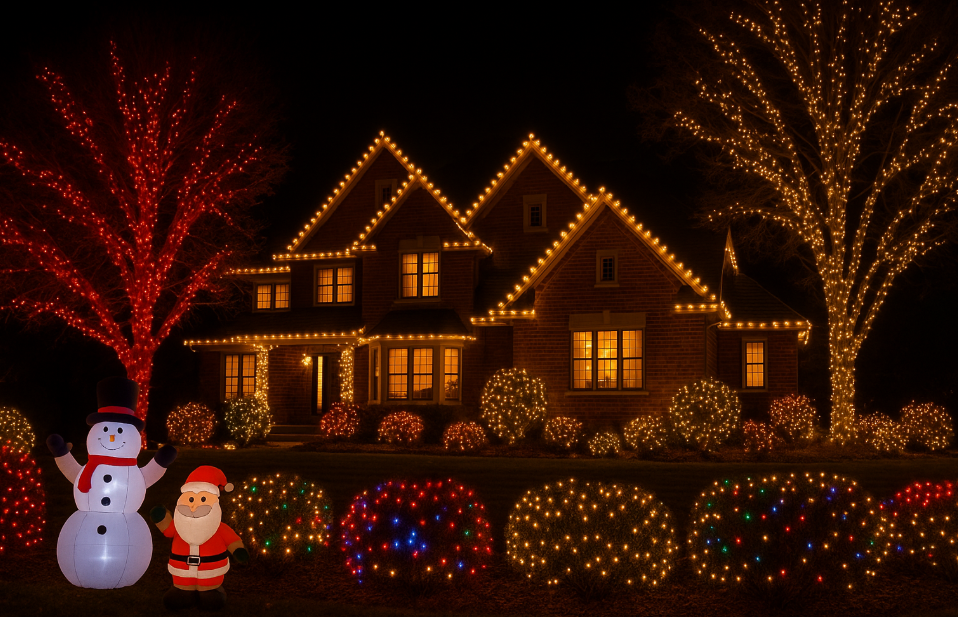
The ultimate neighborhood spectacle includes roof peaks, large trees, inflatables, and more than 6,000 lights. Based on our estimates, keeping this show running for six hours a night can reach $300 or more if you use incandescent bulbs, but switching to LEDs keeps the monthly cost near $40.
How Much Does It Cost to Power Christmas Lights in the Midwest?
Most homeowners don’t think about the true cost of their holiday lights until the January bill arrives. The reality is that the type of lights you choose can make a huge difference.
To put it into perspective, let’s imagine a family in Ohio who strings up 10 strands of traditional incandescent lights. By the end of the season, they could easily spend an extra $15–$20 just to keep them glowing.
If that same family switched to LED strands, their cost would drop to less than a dollar for the entire season. Same festive sparkle, but at a fraction of the cost.
Of course, electricity rates vary from state to state, which means the same holiday display may cost more in one area than another.
Using the most recent average residential electricity rates from the E.I.A. (as of May 2025), here’s what it costs to run 100 Christmas lights in Pennsylvania, Illinois, and Ohio, depending on the type of bulb you use:
Cost to Run Christmas Lights in Pennsylvania (at 19.31¢/kWh)
| Light Type | Cost per Hour | Cost per Day (6 hrs) | Cost per Week (42 hrs) | Cost per Month (180 hrs) |
| Mini Incandescent (50W) | $0.01 | $0.06 | $0.41 | $1.74 |
| C7 (500–700W) | $0.10–$0.14 | $0.58–$0.81 | $4.06–$5.68 | $17.38–$24.33 |
| C9 (700–1,000W) | $0.14–$0.19 | $0.81–$1.16 | $5.68–$8.11 | $24.33–$34.76 |
| LED Mini (4.8W) | <$0.01 | $0.01 | $0.04 | $0.17 |
Cost to Run Christmas Lights in Illinois (at 18.62¢/kWh)
| Light Type | Cost per Hour | Cost per Day (6 hrs) | Cost per Week (42 hrs) | Cost per Month (180 hrs) |
| Mini Incandescent (50W) | $0.01 | $0.06 | $0.39 | $1.68 |
| C7 (500–700W) | $0.09–$0.13 | $0.56–$0.78 | $3.91–$5.47 | $16.76–$23.46 |
| C9 (700–1,000W) | $0.13–$0.19 | $0.78–$1.12 | $5.47–$7.82 | $23.46–$33.52 |
| LED Mini (4.8W) | <$0.01 | $0.01 | $0.04 | $0.16 |
Cost to Run Christmas Lights in Ohio (17.11¢/kWh)
| Light Type | Cost per Hour | Cost per Day (6 hrs) | Cost per Week (42 hrs) | Cost per Month (180 hrs) |
| Mini Incandescent (50W) | $0.01 | $0.05 | $0.36 | $1.54 |
| C7 (500–700W) | $0.09–$0.12 | $0.51–$0.72 | $3.59–$5.03 | $15.40–$21.56 |
| C9 (700–1,000W) | $0.12–$0.17 | $0.72–$1.03 | $5.03–$7.19 | $21.56–$30.80 |
| LED Mini (4.8W) | <$0.01 | $0.00 | $0.03 | $0.15 |
Across the Midwest, it’s clear to see that LED mini strings are by far the cheapest option, costing about one cent a day or only 15–17 cents a month.
Mini incandescents cost roughly ten times more, around $1.50–$1.75 per month, while bigger bulbs can cause your bills to soar. So, if you’re in the Midwest looking to make your holiday display a little more energy-efficient, consider adding LEDs into the mix.
Or, if you’re still watching your budget, maybe trim that over-the-top Halloween display and save those watts (and dollars) for a truly dazzling Christmas show!
Are Christmas Lights Expensive to Run All Night?
Leaving Christmas lights on all night may seem harmless, but it does add to your electric bill. When they're left on for long stretches, the cost can build up quickly.
What many homeowners don't realize is that running lights overnight multiplies the hours of use. One strand alone may not seem like much, but most families decorate with multiple strings indoors and outdoors, wrapping trees, lining the roof, and covering bushes. If those displays stay lit for 10–12 hours a day instead of 4–6, your monthly holiday lighting bill can easily double.
There's also a safety factor to consider. Experts recommend turning off your lights when you go to bed or when you're not home. Older incandescent bulbs can get hot and increase the risk of fire if left unattended for too long. LEDs run cooler and are much safer, but even then, leaving them on all night wastes electricity unnecessarily.
The good news is you don't have to sacrifice the festive look. Many homeowners use timers or smart plugs to automatically switch lights off after a few evening hours. This way, your home still sparkles during the peak times when neighbors and passersby are out without wasting energy in the middle of the night.
LED lights give you the same holiday glow but with lower energy use, significant savings, and longer-lasting performance.
Optimizing Your Christmas Lights Setup for Energy Efficiency
Holiday lights don't have to mean sky-high electric bills. With a few smart choices, you can enjoy the sparkle of the season while keeping your energy use in check. Here are a few of our favorite tips to get you started:
- Swap incandescent bulbs for LEDs – Yep, we're saying it again! LEDs use less energy and last much longer, so you save on both your electric bill and replacement costs.
- Use timers or smart plugs – Setting lights to run only during peak evening hours avoids wasting electricity overnight when no one is awake to enjoy them.
- Choose strategic placement over sheer volume – Highlighting key areas like rooflines, windows, or trees can create the same festive impact without the high energy draw of covering everything.
- Add solar or battery-powered décor – These run independently of your home's power supply, cutting costs and reducing strain on the grid during peak winter demand.
- Replace broken bulbs and check cords – Damaged strands can draw more energy or even pose safety risks; keeping them in good condition ensures efficiency and safety.
FAQs
Do Christmas lights use more electricity than light bulbs?
Traditional incandescent Christmas lights usually use more electricity than a regular household bulb. A standard 60-watt indoor bulb uses about 0.06 kWh per hour, while a 100-light strand of mini incandescents uses roughly 0.05 kWh per hour on its own.
How long should you leave Christmas lights on?
Most safety experts recommend limiting lights to 6–8 hours per night. This reduces fire risk and energy waste.
Is it safe to leave Christmas lights on all night?
We don't recommend it. While LED lights stay cool and are safer, older incandescent bulbs can overheat and increase fire risk if left on unattended.
Do timers save electricity on Christmas lights?
Yes. Timers or smart plugs automatically shut lights off, helping reduce wasted electricity and lowering your bill. If you normally forget and leave the lights on 12 hours a night, but a timer trims that to 6 hours, you instantly cut usage in half.
How many lights can I run on one outlet?
It depends on the circuit. A standard 15-amp household circuit handles about 1,440 watts safely. Incandescents reach that limit quickly, while LEDs allow far more lights on the same outlet.
Christmas lights bring joy and warmth to the season, but they also add to your home's electricity use. The type of lights you choose, how many you put up, and how long you keep them on each night all affect your bill. By switching to energy-efficient LEDs, using timers, and following safety guidelines, you can enjoy a bright and festive home without worry.
Still, even with the best choices, holiday lighting and winter electric heating can make bills unpredictable. That's where Santanna's Unlimited Energy Plan gives you peace of mind. With one flat supply charge each month, you can decorate, celebrate, and keep your home cozy all season long without stressing over surprise spikes on your energy bill.* Find out more today!
* Restrictions apply. Enrollment based upon program eligibility. Customers using more than 125% of normal monthly usage as determined by Santanna may be required to switch plans.
Jenna Mendez is a Midwest native with lifelong roots in Illinois and time spent in Ohio during college, giving her a deep understanding of the Midwest region’s people, climate, and energy needs. She brings firsthand experience and local insight to topics that matter to Midwest homeowners, especially energy efficiency, sustainability, and home living. Jenna specializes in writing about eco-friendly living, all things Midwest, renewable energy, and practical ways to reduce energy costs. Jenna brings a trusted, and local hometown voice to every article she writes, helping readers live well, and sustainably, right where they are.





